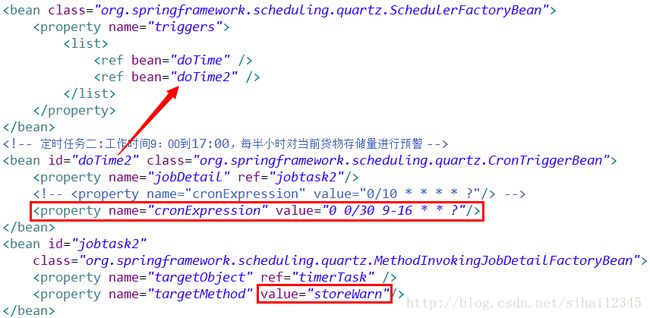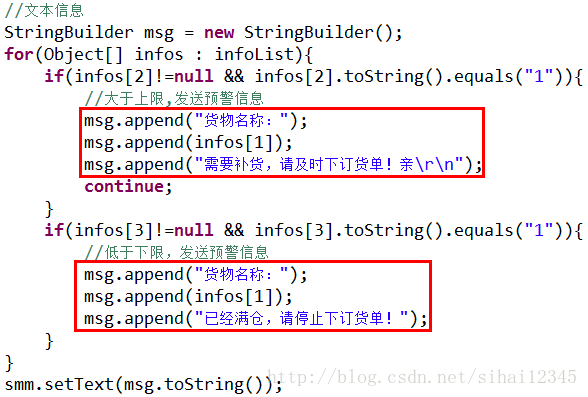【struts2+hibernate+spring项目实战】Spring计时器任务 Spring整合JavaMail(邮件发送)(ssh)
一、常用数据频度维护
对于系统使用度较高的数据,客户在查看时希望这些数据最好先出现,此时需要为其添加排序规则。在进行排序时,使用次数成为排序的依据。因此需要设置一个字段用来描述某种数据的使用次数,也就是所谓的使用频度。
本系统中,商品数据是整体数据流的核心数据,为商品数据添加频度字段。

该字段的值默认为0,每使用一次,将其值自增一。但是如果每次使用都修改该表的对应字段,操作量无疑是巨大的,并且还牵扯到数据库操作的隔离级问题,需要防止并发带来的错误操作。
系统中经常会出现此类任务,即需要修改某些数据的值,但是此数据并不需要具有很强的即时性。只需要在某一个特定时刻,将该值修改即可。
基于上述分析,需要一种机制保障,在特定时间点,将对应商品的使用次数修改为当前已使用的总次数即可。最终数据排序时,以该字段作为排序依据即可。
上述问题需要完成两个任务即可
- 规定时间内循环执行某任务
- 执行特殊的SQL语句,完成修改使用次数字段的任务
二、Spring定时作业调度
Spring提供了定时器任务,用于在规定时间执行对应的任务。
1.定义定时作业任务Bean,及其作业任务对应的操作
/**
* 设备一数据插入(小时)
*/
public void insertHourService1(){
realmEbi = (RealmEbi) ApplicationContextUtil.getBean("realmEbi");
realmEbi.insertHour(RealmApplianceModel.sendData3);
}2.将其配置为Spring管理的Bean
<bean id="timerTask" class="org.sihai.soilmoni.soilrealm.web.SoilRealmAction">
bean>3.定义作业任务
<bean id="jobTask4" class="org.springframework.scheduling.quartz.MethodInvokingJobDetailFactoryBean">
<property name="targetObject" ref="timerTask"/>
<property name="targetMethod" value="insertDayService2"/>
bean>4.定义作业任务的执行时间周期
id="doTime4" class="org.springframework.scheduling.quartz.CronTriggerBean">
<property name="jobDetail" ref="jobTask4"/>
<property name="cronExpression" value="0 59 23 * * ?"/>
5.设置该任务加入定时任务
<bean class="org.springframework.scheduling.quartz.SchedulerFactoryBean">
<property name="triggers">
<list>
<ref bean="doTime"/>
<ref bean="doTime2"/>
<ref bean="doTime3"/>
<ref bean="doTime4"/>
list>
property>
bean>6.修改执行的时间周期值,参看:资源/定时调度Quartz/Cron表达式.txt
设置执行周期为每10秒一次
0/10 * * * * ? 每10秒一次
0/10 * * ? * * 每10秒一次7.源码
<beans xmlns="http://www.springframework.org/schema/beans"
xmlns:xsi="http://www.w3.org/2001/XMLSchema-instance"
xsi:schemaLocation="
http://www.springframework.org/schema/beans
http://www.springframework.org/schema/beans/spring-beans.xsd
">
<bean class="org.springframework.scheduling.quartz.SchedulerFactoryBean">
<property name="triggers">
<list>
<ref bean="doTime"/>
<ref bean="doTime2"/>
<ref bean="doTime3"/>
<ref bean="doTime4"/>
list>
property>
bean>
<bean id="doTime" class="org.springframework.scheduling.quartz.CronTriggerBean">
<property name="jobDetail" ref="jobTask"/>
<property name="cronExpression" value="0 59 23 * * ?"/>
bean>
<bean id="doTime2" class="org.springframework.scheduling.quartz.CronTriggerBean">
<property name="jobDetail" ref="jobTask2"/>
<property name="cronExpression" value="0 59 23 * * ?"/>
bean>
<bean id="doTime3" class="org.springframework.scheduling.quartz.CronTriggerBean">
<property name="jobDetail" ref="jobTask3"/>
<property name="cronExpression" value="0 59 23 * * ?"/>
bean>
<bean id="doTime4" class="org.springframework.scheduling.quartz.CronTriggerBean">
<property name="jobDetail" ref="jobTask4"/>
<property name="cronExpression" value="0 59 23 * * ?"/>
bean>
<bean id="jobTask" class="org.springframework.scheduling.quartz.MethodInvokingJobDetailFactoryBean">
<property name="targetObject" ref="timerTask"/>
<property name="targetMethod" value="insertHourService1"/>
bean>
<bean id="jobTask2" class="org.springframework.scheduling.quartz.MethodInvokingJobDetailFactoryBean">
<property name="targetObject" ref="timerTask"/>
<property name="targetMethod" value="insertHourService2"/>
bean>
<bean id="jobTask3" class="org.springframework.scheduling.quartz.MethodInvokingJobDetailFactoryBean">
<property name="targetObject" ref="timerTask"/>
<property name="targetMethod" value="insertDayService1"/>
bean>
<bean id="jobTask4" class="org.springframework.scheduling.quartz.MethodInvokingJobDetailFactoryBean">
<property name="targetObject" ref="timerTask"/>
<property name="targetMethod" value="insertDayService2"/>
bean>
<bean id="timerTask" class="org.sihai.soilmoni.soilrealm.web.SoilRealmAction">
bean>
beans>
三、常用数据频度维护
使用Spring数据频度调度维护,配置需改数据操作,完成商品使用量频度维护
1.定义维护商品使用频度的SQL语句,执行并验证执行效果
update tbl_goods g set g.useNum = (select count(odm.uuid) from tbl_detail_order odm where odm.goodsUuid = g.uuid)2.将上述任务转化为定时任务方法

注入对应的数据层Bean,并开启事务
四、库存预警功能
库存预警功能是对库存商品数量进行报警的一种机制。当库存商品数量高于或低于指定的预警数量时,产生报警信息。
报警信息可以是如下方案之一
- 发邮件
- 发短信
- 给手机发送消息
- 发出警报消息(ERP系统内发送给主管:主管再将该任务派发到人员:实现方式ServletContext范围内的数据共享,创建集合(必须是多线程安全的)页面设计定时器定时获取该集合数据,每隔一段时间发送AJAX请求,获取预警信息
报警操作必须时刻监控库存商品的数量。如果到达报警临界值,进行指定方式的信息报警。此处使用Email形式进行报警。
1.设置报警定时器任务,当库存商品总数量低于最低值或高于最高值时,发送Email到仓库管理员,进行预警报警。
![]()
2.设置库存预警定时作业调度任务

3.测试定时作业是否成功
4.获取引发预警信息的数据
对库存明细数据进行分组统计求和,如果数量超出对应商品的库存预警值,将该商品加入库存预警信息
select
gm.uuid,
gm.goodsName,
sum(sdm.now)>=gm.maxNum ,
sum(sdm.now)<=gm.minNum
from
tbl_detail_store sdm,
tbl_goods gm
where
sdm.goodsUuid = gm.uuid
group by
sdm.goodsUuid五、Spring整合JavaMail
Spring提供对JavaMail的整合技术,配置JavaMail发送器为Spring管理的Bean,实现Spring管理资源的机制。
1.配置Spring管理的JavaMail发送器对象
<beans xmlns="http://www.springframework.org/schema/beans"
xmlns:xsi="http://www.w3.org/2001/XMLSchema-instance"
xmlns:p="http://www.springframework.org/schema/p"
xmlns:context="http://www.springframework.org/schema/context"
xmlns:tx="http://www.springframework.org/schema/tx"
xmlns:aop="http://www.springframework.org/schema/aop"
xsi:schemaLocation="http://www.springframework.org/schema/beans
http://www.springframework.org/schema/beans/spring-beans.xsd
http://www.springframework.org/schema/aop
http://www.springframework.org/schema/aop/spring-aop.xsd
http://www.springframework.org/schema/tx
http://www.springframework.org/schema/tx/spring-tx.xsd
http://www.springframework.org/schema/context
http://www.springframework.org/schema/context/spring-context.xsd">
<description>JavaMail的配置文件description>
<context:property-placeholder location="classpath:mail.properties"/>
<bean id="mailMessage" class="org.springframework.mail.SimpleMailMessage">
<property name="from" value="${mail.from}">property>
bean>
<bean id="mailSender" class="org.springframework.mail.javamail.JavaMailSenderImpl">
<property name="host" value="${mail.host}">property>
<property name="username" value="${mail.username}">property>
<property name="password" value="${mail.password}">property>
<property name="defaultEncoding" value="UTF-8">property>
<property name="javaMailProperties">
<props>
<prop key="mail.smtp.auth">trueprop>
<prop key="mail.debug">trueprop>
<prop key="mail.smtp.timeout">0prop>
props>
property>
bean>
beans>2.设置发送邮件相关内容
//spring整合javaMail需要注入:
private SimpleMailMessage mailMessage;
private JavaMailSender mailSender;
public void setMailMessage(SimpleMailMessage mailMessage) {
this.mailMessage = mailMessage;
}
public void setMailSender(JavaMailSender mailSender) {
this.mailSender = mailSender;
}
public void saveOrUpdate(final User entity) {
if(UtilFuns.isEmpty(entity.getId())){
//判断id是否有值
//说明id没有值,说明保存
entity.setState(1); //1代表可用
String id = UUID.randomUUID().toString();
entity.setId(id);
entity.getUserinfo().setId(id);
//设置初始密码 需要将默认的密码加密后保存到数据库
entity.setPassword(Encrypt.md5(SysConstant.DEFAULT_PASS, entity.getUserName()));
//final就是延长对象的生命周期,不然entity只能在saveOrUpdate中使用,使用完成后方法弹栈,而run方法内就无法再使用之前定义好的entity。
//使用spring与javaMail实现新员工入职时邮件的发送
//使用线程并try-catch的目的就是如果邮件发送失败,也不影响信息保存到数据库。邮件发送成为了一个独立的过程。
Thread th = new Thread(new Runnable(){
public void run(){
try {
mailMessage.setTo(entity.getUserinfo().getEmail());
mailMessage.setSubject("新员工入职信息");
mailMessage.setText("欢迎"+entity.getUserinfo().getName()+"加入廊坊思创志远科技有限公司,您在公司的账号:"+entity.getUserName()+",密码:"+SysConstant.DEFAULT_PASS);
mailSender.send(mailMessage);
} catch (MailException e) {
e.printStackTrace();
}
}
});
th.start();
}
baseDao.saveOrUpdate(entity);
} 如果想获取更多源码或者视频教程,欢迎关注我的微信公众号
好好学java,在公众号里,回复:java基础、html5、javaEE基础、struts2、spring、redis、luncene、oracle等,将可获得以上的优质视频教程及源码。




